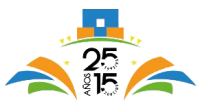Objective Refraction with Self-Operable, Lightweight Autorefractor for Space Flight Applications

| AUTHORS | |
| Conference | 2022 NASA Human Research Program Investigator´s WorkShop (Online Conference) |
|
INTRODUCTION Hyperopic refractive error shift along with optic disc edema, choroidal folds, nerve fiber layer infarcts, globe flattening are referred to as spaceflight-associated neuro-ocular syndrome (SANS) [1][2]. Although the observed hyperopic shift can be corrected with eyeglasses, the time course of all these visual changes in microgravity is not well elucidated, due to the need for an accurate, precise, and easy-to-use instrument. Ophthalmic instruments that are highly repeatable such as autorefractors and optical biometers, do not meet the portability requirements for space flights [3]. Towards this need, we modified a portable handheld autorefractor (QuickSee, PlenOptika), that provides binocular objective measurements in 10 seconds, to reduce its weight and improve its form factor. This study evaluates the ability of the new prototype to accurately and repeatably assess small variations in refractive error to mimic hyperopic changes in a subject’s refractive power, and thus, its suitability as a technology for indirectly monitoring changes in axial length of the eye under microgravity conditions.
MATERIALS AND METHODS Forty subjects (22-30 years old) in an IRB-approved clinical study at New England College of Optometry (NECO) participated in this study. By adding soft contact lenses of varying hyperopic power (0.25, 0.5 and 0.75 D) to patient’s eyes, a controllable refractive error change was induced, and the new prototype’s accuracy and repeatability was quantified. Cycloplegic autorefraction using all the contact lenses was performed 30 minutes after the installation of drops to neutralize accommodation effects. Repeatability of the device was evaluated by comparing repeated measurements of the subjects (2-3 measurements per patient) and accuracy was calculated using the average difference respect to expected spherical refraction. Due to non-significant differences, only the analysis of right eyes is presented. RESULTS AND DISCUSSION The prototype achieved a reduction in weight from 1.1kg to 0.55kg with an improvement of the overall form-factor and viewing experience (Figure 1). Average differences (± SD) between expected spherical refraction and autorefraction where of 0.05 ± 0.31 D, 0.05 ± 0.32 D, and 0.16 ± 0.36 D for induced hyperopic shifts of 0.25, 0.5 and 0.75 D, respectively. Since a 1-D change in mean spherical error correlates to a change in axial length of approximately 370 µm [3], the device used in the study would be able to accurately quantify changes of 93 microns (0.25D). Bland-Altman analysis of repeated measurements indicated a mean bias error of -0.01 and 95% limits of agreement (calculated as 1.96 x SD of the differences) of +/- 0.56 D (Figure 2). These limits of agreement in intersession measurement (0.56 D ≈ 207 µm) indicates that a single change in refraction of 0.56 D could be considered a significant change very unlikely to occur by chance. Since average spherical equivalent change after spaceflight is on the order of 0.8 D (0.75 to 1.75 D range) [3], a single measurement with the autorefractor would be sufficient to detect the degree of change typically expected in space. CONCLUSION The custom, light prototype, demonstrated promise as a tool for monitoring refractive changes and hyperopic shift during long-duration space flight. This was despite issues with the fit of contact lens on the patient’s eye including lens decentration or patients blinking, which affected over-refraction measurements and made it challenging to obtain satisfactory endpoints for some patients. REFERENCES [1] A. G. Lee, et al (2017) JAMA Ophthalmol 135(9), 992–994. [2] T. H Mader, et al (2011) Ophthalmology 118(10), 2058-2069. [3] K. S. Masterova et al (2018) Aerosp. Med. Hum. Perform. 89(8), 724–730. |
|
| LINK | here |



